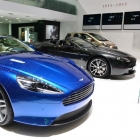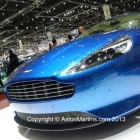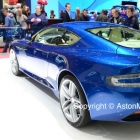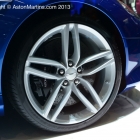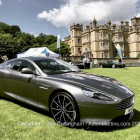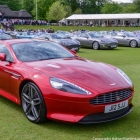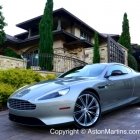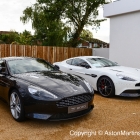The Gen4 VH architecture features significant changes to the underbody structure which includes lowering the engine by 19mm. This has principally been done for compliance with the latest European Pedestrian Protection regulation without the need for complex deployable systems. That said, lowering of the engine has contributed to lowering the centre of gravity of the DB9 as a whole improving handling and driver response. The ‘new’ DB9 has a 20% increase in stiffness over the original model, it is also 15 kg lighter too.
The AM11 spec engine in the ‘new’ DB9 is exactly the same as fitted to the range topping Vanquish, but has been tuned to suit the character of the DB9. With peak power of 510 bhp, it is 40 bhp more powerful than the 2009MY DB9, 20 bhp more powerful than the previous Virage is therefore equal to the previous range topping GT, the DBS. As with the later original DB9 and Virage, the Gen4 DB9 is only available with six speed Touchtronic transmission with no manual option.
The ‘new’ DB9 braking system uses drilled Brembo Carbon Ceramic Matrix (CCM) discs and monoblock calipers. The brakes are around 12.5kg lighter than a conventional system and on a GT in the price range of the DB9, CCM braking technology is rarely fitted as standard.
The 2013MY DB9 features Aston Martin’s ‘Gen4’ VH architecture version of the Adaptive Damping System (ADS). This next generation of ADS has been enhanced to include three modes; Normal, to deliver the greatest ride comfort, Sport, focused at delivering sharper handling and Track mode, where the damping operates within the range of the stiffest settings.
As with the previous Virage, the same 20 inch wheels come as standard, either 5 spoke as standard or a 10 spoke wheel as a cost option. In addition a new 10 spoke sport wheel, previously available on the DBS is available each of which is a kilo lighter than the standard wheel. Pirelli P Zero tyres are standard fit on the DB9 although Pirelli P Zero Corsa performance tyres are a cost option.
Two small but useful additions to the 2013MY DB9 are automatic rain sensing wipers and also headlights which automatically turn on and off according to the light levels in the surrounding environment. The ‘new’ DB9 can be specified as a 2+2 or as a 2+0 with lightweight seats use a carbon fibre and Kevlar composite structure, manufactured by Belco Avia, who also supply the motorsports and aerospace industries. By specifying the lightweight seats, their is a significant weight saving of 17 kg per car.
Identifying the ‘new’ DB9 from the outgoing Virage is really quite difficult. All of the special features of the Virage such as the aerosol section front grille, revised side strake design, bi-xenon headlights, glass switches and the welt feature in the interior. One way is that the DB9 has a pronounced flip-up on the boot lid. Also as an option, the DB9 can be specified with an exterior carbon pack comprising carbon fibre front splitter, rear diffuser, exterior mirror heads and mirror arms as well as a graphitic finish tail pipe trim.
Production of the revised DB9 ended in the Summer of 2015 and the car was replaced by the more powerful DB9 GT.




